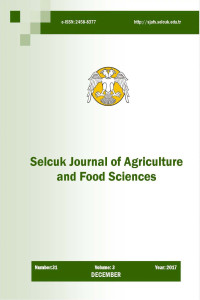Variable Response of Leaf Temperature, Tissue Density and Greenness of ‘Michele Palieri’ (Vitis vinifera L.) Grapevines to Water Stress under Different Rootstock Effects
Öz
Most vineyards around the world are established in regions exposed to seasonaldrought where soil and atmospheric water deficits, together with high temperatures, exert large constraints on grapevines. Therefore, the increasing demand for vineyard irrigation requires an improvement in the efficiency of water use, such as deficit irrigation to allow plants withstand mild water stress. The present study was performed to reveal certain leaf physiological bases of grapevine responses to mild water deficits under various rootstock effects. Two irrigation levels (field capacity and 50% of field capacity) were applied to two years old vines of ‘Michele Palieri’ table grape cultivar, using 5 different rootstock, including own rooted vines. Investigations revealed that rootstocks have remarkable effects on leaf greenness (estimation of leaf chlorophyll content by SPAD meter readings) and slight effects on leaf temperature. Leaf tissue density also changed according to the rootstock use. Overall, deficit irrigation at 40% of field capacity may be a potential deficit irrigation program for grapevines when accurately optimized according to specific requirements of different grapevine genotypes.
Anahtar Kelimeler
Drought stress Leaf physiology Deficit irrigation Grapevine rootstock
Ayrıntılar
| Birincil Dil | İngilizce |
|---|---|
| Konular | Bahçe Bitkileri Yetiştirme ve Islahı |
| Bölüm | Araştırma Makalesi |
| Yazarlar | |
| Yayımlanma Tarihi | 29 Aralık 2017 |
| Gönderilme Tarihi | 13 Haziran 2017 |
| Yayımlandığı Sayı | Yıl 2017 Cilt: 31 Sayı: 3 |
Kaynak Göster
Selcuk Journal of Agriculture and Food Sciences Creative Commons Atıf-GayriTicari 4.0 Uluslararası Lisansı (CC BY NC) ile lisanslanmıştır.

